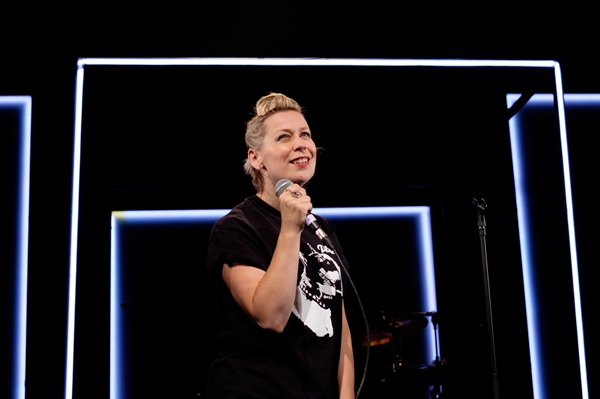It’s the early nineties and we are at the cusp of britpop and near the abrupt ending of grunge. Cora Bissett has just joined the Fife based band Darlingheart. They are looking for the ever elusive record deal and hopefully their big break in the music industry. However, unlike countless other bands from small towns across the UK, Darlingheart strike gold. Within a few months they are given a five album deal, tours with Radiohead and Blur and the opportunity to record an album. What Girls Are Made Of charts writer and performer Cora Bissett’s adventures in the music business, but this story is not that simple. Themes of memory, family and artistic expression give What Girls Are Made Of a degree of heart, passion and warmth – and there is a kick ass band to soundtrack the entire experience.
We begin with Cora addressing the audience whilst she tenderly grasps a large cardboard box. She recounts how she recently found press clippings of her time with Darlingheart when clearing out her parents attic. This is where our story begins. Cora is joined onstage by three musicians that include Susan Bear (formerly of great Glasgow band Tuff Love), Simon Donaldson and Grant O’Rourke. The band are more than just backing musicians, with each taking on different roles throughout the play. Parents, record industry moguls and bank managers are all brought to life by the performers. Meanwhile the rendition of Blur track This is A Low and In Bloom by Nirvana, set the scene and work as means to express the deep emotion of the performance. Cora’s ability with language also gives the show added intensity. She describes Robert Mapplethorpe’s iconic photograph of Patti Smith in such vivid detail that the image feels alive and vibrant and a complete source of inspiration.
The show concludes with Cora’s own interpretation of the Patti Smith classic Land. She owns the stage, leaping around with complete freedom, fully expressing herself without the burden of a record label, a horrendous and distrustful manager, snooty journalists and the pressure of London life. But the true freedom here is the ability to pass her knowledge and inspiration onward to a new generation of young women. This conclusion is deeply touching, effective and profound.
With the Rip It Up exhibition at the National Museum of Scotland and the accompanying book, radio and television documentaries, 2018 feels very much the time to celebrate the achievements of Scottish music and musicians. Cora Bissett’s tale is very much part of the wider narrative of Scottish pop music and how it continues to inspire and rouse emotions.
